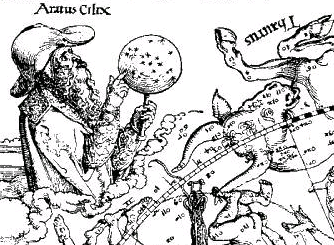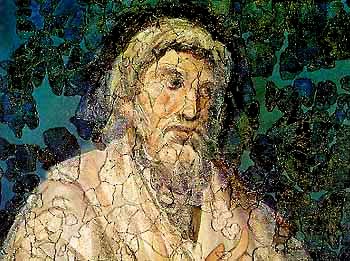|
Aega (mythology)
In Greek mythology, Aega (Ancient Greek: Αίγη) or Pine or Cynosura or Melissa was, according to Hyginus, a daughter of Olenus, who was a descendant of Hephaestus. Aega and her sister Helice nursed the infant Zeus in Crete, and the former was afterwards changed by the god into the constellation called Capella. Mythology According to other traditions mentioned by Hyginus, Aega was a daughter of Melisseus, king of Crete, and was chosen to suckle the infant Zeus; but as she was found unable to do it, the service was performed by the goat Amalthea. Hyginus also reports a tradition that while married to Pan she had a son by Zeus whom she called Aegipan. According to other authors, Aega was a daughter of Helios and of such dazzling brightness that the Titans in their attack upon Olympus became frightened and requested their mother Gaia to conceal her in the earth. She was accordingly confined in a cave in Crete, where she became the nurse of Zeus. In the Titanomachy, Zeus ... [...More Info...] [...Related Items...] OR: [Wikipedia] [Google] [Baidu] |
Greek Mythology
A major branch of classical mythology, Greek mythology is the body of myths originally told by the ancient Greeks, and a genre of Ancient Greek folklore. These stories concern the origin and nature of the world, the lives and activities of deities, heroes, and mythological creatures, and the origins and significance of the ancient Greeks' own cult and ritual practices. Modern scholars study the myths to shed light on the religious and political institutions of ancient Greece, and to better understand the nature of myth-making itself. The Greek myths were initially propagated in an oral-poetic tradition most likely by Minoan and Mycenaean singers starting in the 18th century BC; eventually the myths of the heroes of the Trojan War and its aftermath became part of the oral tradition of Homer's epic poems, the '' Iliad'' and the '' Odyssey''. Two poems by Homer's near contemporary Hesiod, the '' Theogony'' and the '' Works and Days'', contain accounts of the genes ... [...More Info...] [...Related Items...] OR: [Wikipedia] [Google] [Baidu] |
Gaia (mythology)
In Greek mythology, Gaia (; from Ancient Greek , a poetical form of , 'land' or 'earth'),, , . also spelled Gaea , is the personification of the Earth and one of the Greek primordial deities. Gaia is the ancestral mother—sometimes parthenogenic—of all life. She is the mother of Uranus (the sky), from whose sexual union she bore the Titans (themselves parents of many of the Olympian gods), the Cyclopes, and the Giants; as well as of Pontus (the sea), from whose union she bore the primordial sea gods. Her equivalent in the Roman pantheon was Terra.''Larousse Desk Reference Encyclopedia'', The Book People, Haydock, 1995, p. 215. Etymology The Greek name Γαῖα (''Gaia'' or ) is a mostly epic, collateral form of Attic (''Gē'' ), and Doric (''Ga'' ), perhaps identical to (''Da'' ), both meaning "Earth". The word is of uncertain origin. Beekes suggested a Pre-Greek origin. Robert S. P. Beekes, ''Etymological Dictionary of Greek'', Brill, 2009, pp. 269–270 ... [...More Info...] [...Related Items...] OR: [Wikipedia] [Google] [Baidu] |
Women In Greek Mythology
A woman is an adult female human. Prior to adulthood, a female human is referred to as a girl (a female child or adolescent). The plural ''women'' is sometimes used in certain phrases such as "women's rights" to denote female humans regardless of age. Typically, women inherit a pair of X chromosomes, one from each parent, and are capable of pregnancy and giving birth from puberty until menopause. More generally, sex differentiation of the female fetus is governed by the lack of a present, or functioning, SRY-gene on either one of the respective sex chromosomes. Female anatomy is distinguished from male anatomy by the female reproductive system, which includes the ovaries, fallopian tubes, uterus, vagina, and vulva. A fully developed woman generally has a wider pelvis, broader hips, and larger breasts than an adult man. Women have significantly less facial and other body hair, have a higher body fat composition, and are on average shorter and less muscular than men. Th ... [...More Info...] [...Related Items...] OR: [Wikipedia] [Google] [Baidu] |
Dictionary Of Greek And Roman Biography And Mythology
The ''Dictionary of Greek and Roman Biography and Mythology'' (1849, originally published 1844 under a slightly different title) is an encyclopedia/biographical dictionary. Edited by William Smith, the dictionary spans three volumes and 3,700 pages. It is a classic work of 19th-century lexicography. The work is a companion to Smith's '' Dictionary of Greek and Roman Antiquities'' and ''Dictionary of Greek and Roman Geography''. Authors and scope The work lists thirty-five authors in addition to the editor, who was also the author of the unsigned articles. The other authors were classical scholars, primarily from Oxford, Cambridge, Rugby School, and the University of Bonn, but some were from other institutions. Many of the mythological entries were the work of the German expatriate Leonhard Schmitz, who helped to popularise German classical scholarship in Britain. With respect to biographies, Smith intended to be comprehensive. In the preface, he writes: Much of the v ... [...More Info...] [...Related Items...] OR: [Wikipedia] [Google] [Baidu] |
Aratus
Aratus (; grc-gre, Ἄρατος ὁ Σολεύς; c. 315 BC/310 BC240) was a Greek didactic poet. His major extant work is his hexameter poem ''Phenomena'' ( grc-gre, Φαινόμενα, ''Phainómena'', "Appearances"; la, Phaenomena), the first half of which is a verse setting of a lost work of the same name by Eudoxus of Cnidus. It describes the constellations and other celestial phenomena. The second half is called the ''Diosemeia'' (Διοσημεῖα "Forecasts"), and is chiefly about weather lore. Although Aratus was somewhat ignorant of Greek astronomy, his poem was very popular in the Greek and Roman world, as is proven by the large number of commentaries and Latin translations, some of which survive. Life There are several accounts of Aratus's life by anonymous Greek writers, and the Suda and Eudocia also mention him. From these it appears that he was a native of Soli in Cilicia, (although one authority says Tarsus). He is known to have studied with Menecrate ... [...More Info...] [...Related Items...] OR: [Wikipedia] [Google] [Baidu] |
Goat
The goat or domestic goat (''Capra hircus'') is a domesticated species of goat-antelope typically kept as livestock. It was domesticated from the wild goat (''C. aegagrus'') of Southwest Asia and Eastern Europe. The goat is a member of the animal family Bovidae and the tribe Caprini, meaning it is closely related to the sheep. There are over 300 distinct breeds of goat.Hirst, K. Kris"The History of the Domestication of Goats".'' About.com''. Accessed August 18, 2008. It is one of the oldest domesticated species of animal, according to archaeological evidence that its earliest domestication occurred in Iran at 10,000 calibrated calendar years ago. Goats have been used for milk, meat, fur, and skins across much of the world. Milk from goats is often turned into goat cheese. Female goats are referred to as ''does'' or ''nannies'', intact males are called ''bucks'' or ''billies'', and juvenile goats of both sexes are called ''kids''. Castrated males are called ''we ... [...More Info...] [...Related Items...] OR: [Wikipedia] [Google] [Baidu] |
Nymph
A nymph ( grc, νύμφη, nýmphē, el, script=Latn, nímfi, label=Modern Greek; , ) in ancient Greek folklore is a minor female nature deity. Different from Greek goddesses, nymphs are generally regarded as personifications of nature, are typically tied to a specific place or landform, and are usually depicted as maidens. They were not necessarily immortal, but lived much longer than human beings. They are often divided into various broad subgroups, such as the Meliae (ash tree nymphs), the Dryads (oak tree nymphs), the Naiads (freshwater nymphs), the Nereids (sea nymphs), and the Oreads (mountain nymphs). Nymphs are often featured in classic works of art, literature, mythology, and fiction. Since the Middle Ages, nymphs have been sometimes popularly associated or even confused with fairies. Etymology The Greek word has the primary meaning of "young woman; bride, young wife" but is not usually associated with deities in particular. Yet the etymology of the noun rem ... [...More Info...] [...Related Items...] OR: [Wikipedia] [Google] [Baidu] |
The Divine Institutes
''Institutiones Divinae'' (, ; ''The Divine Institutes'') is the name of a theological work by the Christian Roman philosopher Lactantius, written between AD 303 and 311. Contents Arguably the most important of Lactantius's works, the ''Divinae institutiones''the title of which was meant to correspond to the ''institutiones'' that expressed the workings of civil lawis both a systematic as well as apologetic work that, as Patrick Healy argues, "point out the futility of pagan beliefs and to establish the reasonableness and truth of Christianity."McDonald (1964a), p. xiv. The work was the first full attempt to defend Christian theology in Latin, and it was likely written to appeal to and convince educated pagans. While Lactantius focused much of ''Divinae institutiones'' on combating the claims of pagan writers (who at the time were aiding the persecutors of Christianity by writing specialized attack pamphlets), the author also sought to make his work "sufficiently broad" so that i ... [...More Info...] [...Related Items...] OR: [Wikipedia] [Google] [Baidu] |
Lactantius
Lucius Caecilius Firmianus Lactantius (c. 250 – c. 325) was an early Christian author who became an advisor to Roman emperor, Constantine I, guiding his Christian religious policy in its initial stages of emergence, and a tutor to his son Crispus. His most important work is the '' Institutiones Divinae'' ("The Divine Institutes"), an apologetic treatise intended to establish the reasonableness and truth of Christianity to pagan critics. He is best known for his apologetic works, widely read during the Renaissance by humanists, who called Lactantius the "Christian Cicero". Also often attributed to Lactantius is the poem '' The Phoenix'', which is based on the myth of the phoenix from Egypt and Arabia. Though the poem is not clearly Christian in its motifs, modern scholars have found some literary evidence in the text to suggest the author had a Christian interpretation of the eastern myth as a symbol of resurrection. Biography Lactantius was of Punic or Berber origin, b ... [...More Info...] [...Related Items...] OR: [Wikipedia] [Google] [Baidu] |
Antoninus Liberalis
Antoninus Liberalis ( el, Ἀντωνῖνος Λιβεράλις) was an Ancient Greek grammarian who probably flourished between AD 100 and 300. His only surviving work is the ''Metamorphoses'' (Μεταμορφώσεων Συναγωγή, ''Metamorphoseon Synagoge'', literally "Collection of Transformations"), a collection of forty-one very briefly summarised tales about mythical metamorphoses effected by offended deities, unique in that they are couched in prose, not verse. The literary genre of myths of transformations of men and women, heroes and nymphs, into stars (see ''Catasterismi''), plants and animals, or springs, rocks and mountains, were widespread and popular in the classical world. This work has more polished parallels in the better-known ''Metamorphoses'' of Ovid and in the ''Metamorphoses'' of Lucius Apuleius. Like them, its sources, where they can be traced, are Hellenistic works, such as Nicander's ''Heteroeumena'' and ''Ornithogonia'' ascribed to Boios. Th ... [...More Info...] [...Related Items...] OR: [Wikipedia] [Google] [Baidu] |
Catasterismi
The ''Catasterismi'' or ''Catasterisms'' (Greek Καταστερισμοί ''Katasterismoi'', "Constellations" or "Placings Among the Stars"), is a lost work attributed to Eratosthenes of Cyrene. It was a comprehensive compendium of astral mythology including origin myths of the stars and constellations. Only a summary of the original work survives, called the ''Epitome Catasterismorum'', by an unknown author sometimes referred to as pseudo-Eratosthenes. Summary The ''Epitome'' records the mature and definitive development of a long process: the Hellenes' assimilation of a Mesopotamian zodiac, transmitted through Persian interpreters and translated and harmonized with the known terms of Greek mythology. A fundamental effort in this translation was the application of Greek mythic nomenclature to designate individual stars, both asterisms like the Pleiades and Hyades, and the constellations. In Classical Greece, the "wandering stars" and the gods who directed them were separ ... [...More Info...] [...Related Items...] OR: [Wikipedia] [Google] [Baidu] |

.jpg)






